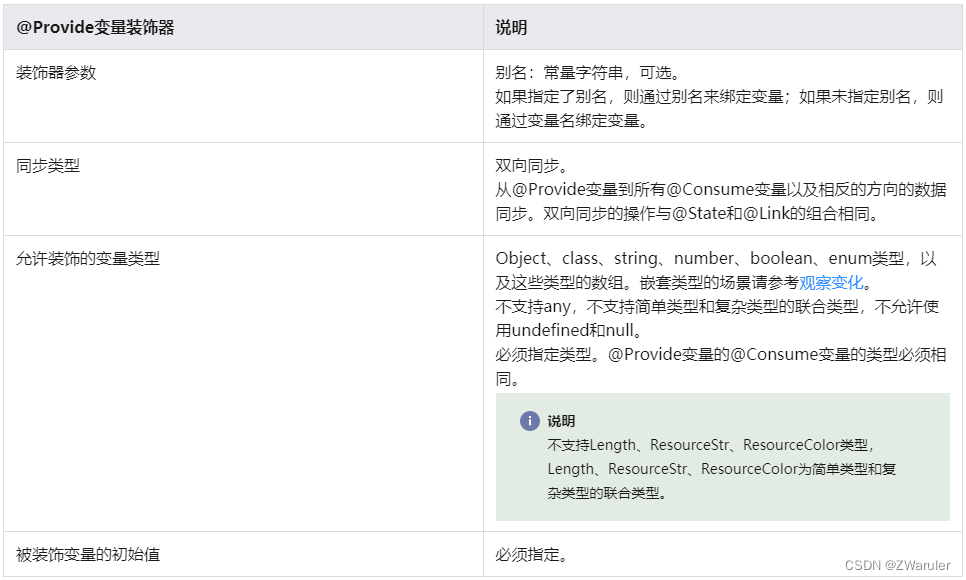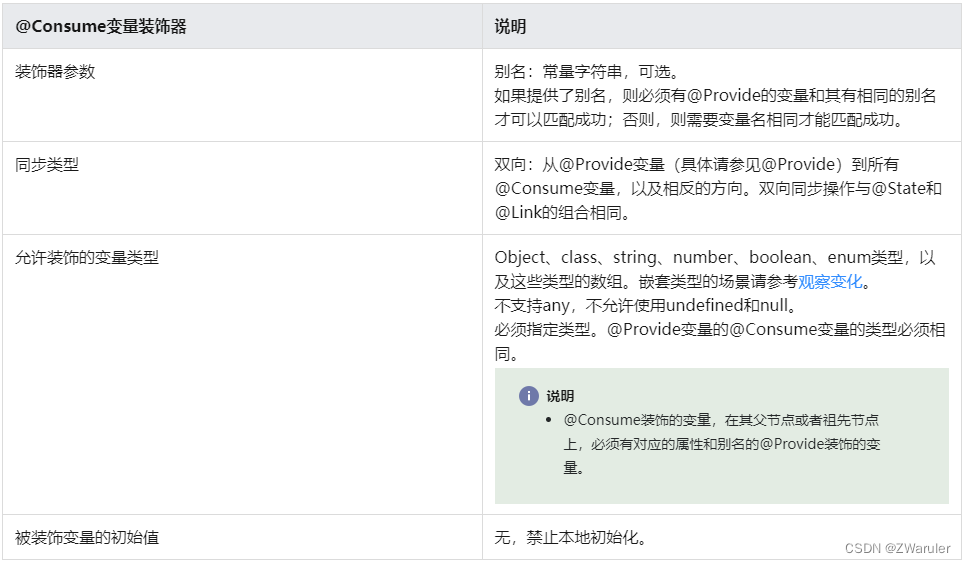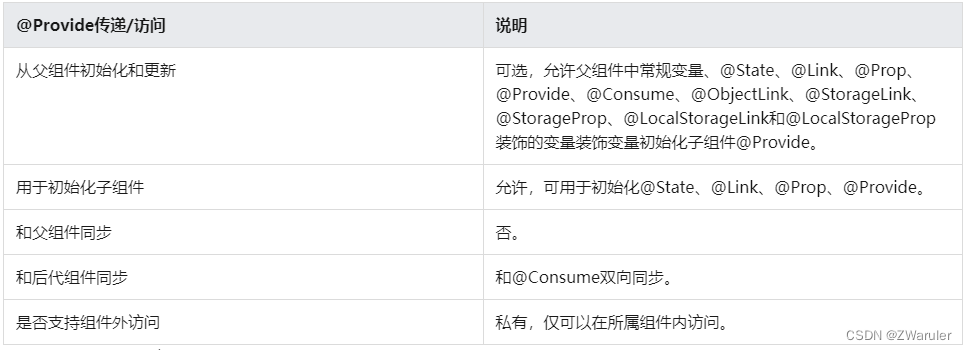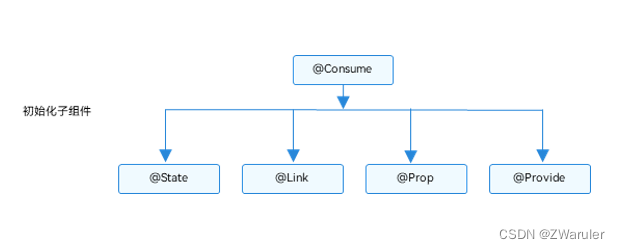- 1七,USB设备驱动 - 分析USB储存驱动程序_usb_device_id
- 2电脑连接linux软件,putty工具的使用 windows连接linux操作
- 3LaTeX在表格中插入图片(以表格tabular方式添加照片到简历信息并排显示)_\faenvelope
- 4Http协议
- 5开发小记-Content Provider获取调用者包名_contentprovider 获取调用者
- 6人机交互软件工程视角 课后习题答案_人机交互与软件工程讨论题
- 7Unity重新激活个人账号流程
- 8架构开场介绍&&环境准备_01期中架构开场介绍&&环境准备
- 9flume环境配置-传输Hadoop日志(namenode或datanode日志)_启动flume传输hadoop日志(namenode或datanode日志),查看hdfs中/tmp
- 10利用VScode搭建Flutter环境开发_flutter vscode
鸿蒙开发笔记(六):状态管理,组件状态管理 @Provide @Consume, @Observed @ObjectLink_鸿蒙开发 objectlink
赞
踩
1. @Provide装饰器和@Consume装饰器:与后代组件双向同步
@Provide和@Consume,应用于与后代组件的双向数据同步,应用于状态数据在多个层级之间传递的场景。不同于上文提到的父子组件之间通过命名参数机制传递,@Provide和@Consume摆脱参数传递机制的束缚,实现跨层级传递。
其中@Provide装饰的变量是在祖先节点中,可以理解为被“提供”给后代的状态变量。@Consume装饰的变量是在后代组件中,去“消费(绑定)”祖先节点提供的变量。
@Provide/@Consume装饰的状态变量有以下特性:
-
@Provide装饰的状态变量自动对其所有后代组件可用,即该变量被“provide”给他的后代组件。由此可见,@Provide的方便之处在于,开发者不需要多次在组件之间传递变量。
-
后代通过使用@Consume去获取@Provide提供的变量,建立在@Provide和@Consume之间的双向数据同步,与@State/@Link不同的是,前者可以在多层级的父子组件之间传递。
-
@Provide和@Consume可以通过相同的变量名或者相同的变量别名绑定,变量类型必须相同。
// 通过相同的变量名绑定
@Provide a: number = 0;
@Consume a: number;
// 通过相同的变量别名绑定
@Provide('a') b: number = 0;
@Consume('a') c: number;
- 1
- 2
- 3
- 4
- 5
- 6
- 7
@Provide和@Consume通过相同的变量名或者相同的变量别名绑定时,@Provide修饰的变量和@Consume修饰的变量是一对多的关系。不允许在同一个自定义组件内,包括其子组件中声明多个同名或者同别名的@Provide装饰的变量。
1.1 装饰器说明
@State的规则同样适用于@Provide,差异为@Provide还作为多层后代的同步源。


1.2 变量的传递/访问规则说明




1.3 观察变化和行为表现
观察变化
-
当装饰的数据类型为boolean、string、number类型时,可以观察到数值的变化。
-
当装饰的数据类型为class或者Object的时候,可以观察到赋值和属性赋值的变化(属性为Object.keys(observedObject)返回的所有属性)。
-
当装饰的对象是array的时候,可以观察到数组的添加、删除、更新数组单元。
框架行为
-
初始渲染:
a. @Provide装饰的变量会以map的形式,传递给当前@Provide所属组件的所有子组件;
b. 子组件中如果使用@Consume变量,则会在map中查找是否有该变量名/alias(别名)对应的@Provide的变量,如果查找不到,框架会抛出JS ERROR;
c. 在初始化@Consume变量时,和@State/@Link的流程类似,@Consume变量会保存在map中查找到的@Provide变量,并把自己注册给@Provide。 -
当@Provide装饰的数据变化时:
a. 通过初始渲染的步骤可知,子组件@Consume已把自己注册给父组件。父组件@Provide变量变更后,会遍历更新所有依赖它的系统组件(elementid)和状态变量(@Consume);
b. 通知@Consume更新后,子组件所有依赖@Consume的系统组件(elementId)都会被通知更新。以此实现@Provide对@Consume状态数据同步。 -
当@Consume装饰的数据变化时:
a. 通过初始渲染的步骤可知,子组件@Consume持有@Provide的实例。在@Consume更新后调用@Provide的更新方法,将更新的数值同步回@Provide,以此实现@Consume向@Provide的同步更新。
1.4 使用场景
在下面的示例是与后代组件双向同步状态@Provide和@Consume场景。当分别点击CompA和CompD组件内Button时,reviewVotes 的更改会双向同步在CompA和CompD中。
@Component struct CompD { // @Consume装饰的变量通过相同的属性名绑定其祖先组件CompA内的@Provide装饰的变量 @Consume reviewVotes: number; build() { Column() { Text(`reviewVotes(${this.reviewVotes})`) Button(`reviewVotes(${this.reviewVotes}), give +1`) .onClick(() => this.reviewVotes += 1) } .width('50%') } } @Component struct CompC { build() { Row({ space: 5 }) { CompD() CompD() } } } @Component struct CompB { build() { CompC() } } @Entry @Component struct CompA { // @Provide装饰的变量reviewVotes由入口组件CompA提供其后代组件 @Provide reviewVotes: number = 0; build() { Column() { Button(`reviewVotes(${this.reviewVotes}), give +1`) .onClick(() => this.reviewVotes += 1) CompB() } } }
- 1
- 2
- 3
- 4
- 5
- 6
- 7
- 8
- 9
- 10
- 11
- 12
- 13
- 14
- 15
- 16
- 17
- 18
- 19
- 20
- 21
- 22
- 23
- 24
- 25
- 26
- 27
- 28
- 29
- 30
- 31
- 32
- 33
- 34
- 35
- 36
- 37
- 38
- 39
- 40
- 41
- 42
- 43
- 44
- 45
- 46
2. @Observed装饰器和@ObjectLink装饰器:嵌套类对象属性变化
上文所述的装饰器仅能观察到第一层的变化,但是在实际应用开发中,应用会根据开发需要,封装自己的数据模型。对于多层嵌套的情况,比如二维数组,或者数组项class,或者class的属性是class,他们的第二层的属性变化是无法观察到的。这就引出了@Observed/@ObjectLink装饰器。
@ObjectLink和@Observed类装饰器用于在涉及嵌套对象或数组的场景中进行双向数据同步:
-
被@Observed装饰的类,可以被观察到属性的变化;
-
子组件中@ObjectLink装饰器装饰的状态变量用于接收@Observed装饰的类的实例,和父组件中对应的状态变量建立双向数据绑定。这个实例可以是数组中的被@Observed装饰的项,或者是class object中的属性,这个属性同样也需要被@Observed装饰。
-
单独使用@Observed是没有任何作用的,需要搭配@ObjectLink或者@Prop使用。
限制条件
使用@Observed装饰class会改变class原始的原型链,@Observed和其他类装饰器装饰同一个class可能会带来问题。
2.1 装饰器说明


@ObjectLink装饰的数据为可读示例。
// 允许@ObjectLink装饰的数据属性赋值
this.objLink.a= ...
// 不允许@ObjectLink装饰的数据自身赋值
this.objLink= ...
- 1
- 2
- 3
- 4
@ObjectLink装饰的变量不能被赋值,如果要使用赋值操作,请使用@Prop。
-
@Prop装饰的变量和数据源的关系是是单向同步,@Prop装饰的变量在本地拷贝了数据源,所以它允许本地更改,如果父组件中的数据源有更新,@Prop装饰的变量本地的修改将被覆盖;
-
@ObjectLink装饰的变量和数据源的关系是双向同步,@ObjectLink装饰的变量相当于指向数据源的指针。如果一旦发生@ObjectLink装饰的变量的赋值,则同步链将被打断。
2.2 变量的传递/访问规则说明


2.3 观察变化和行为表现
观察的变化
@Observed装饰的类,如果其属性为非简单类型,比如class、Object或者数组,也需要被@Observed装饰,否则将观察不到其属性的变化。
class ClassA { public c: number; constructor(c: number) { this.c = c; } } @Observed class ClassB { public a: ClassA; public b: number; constructor(a: ClassA, b: number) { this.a = a; this.b = b; } }
- 1
- 2
- 3
- 4
- 5
- 6
- 7
- 8
- 9
- 10
- 11
- 12
- 13
- 14
- 15
- 16
- 17
- 18
以上示例中,ClassB被@Observed装饰,其成员变量的赋值的变化是可以被观察到的,但对于ClassA,没有被@Observed装饰,其属性的修改不能被观察到。
@ObjectLink b: ClassB
// 赋值变化可以被观察到
this.b.a = new ClassA(5)
this.b.b = 5
// ClassA没有被@Observed装饰,其属性的变化观察不到
this.b.a.c = 5
- 1
- 2
- 3
- 4
- 5
- 6
- 7
- 8
@ObjectLink:@ObjectLink只能接收被@Observed装饰class的实例,可以观察到:
-
其属性的数值的变化,其中属性是指Object.keys(observedObject)返回的所有属性,示例请参考嵌套对象。
-
如果数据源是数组,则可以观察到数组item的替换,如果数据源是class,可观察到class的属性的变化,示例请参考对象数组。
框架行为
- 初始渲染:
a. @Observed装饰的class的实例会被不透明的代理对象包装,代理了class上的属性的setter和getter方法
b. 子组件中@ObjectLink装饰的从父组件初始化,接收被@Observed装饰的class的实例,@ObjectLink的包装类会将自己注册给@Observed class。
2.4 使用场景
嵌套对象
以下是嵌套类对象的数据结构。
// objectLinkNestedObjects.ets let NextID: number = 1; @Observed class ClassA { public id: number; public c: number; constructor(c: number) { this.id = NextID++; this.c = c; } } @Observed class ClassB { public a: ClassA; constructor(a: ClassA) { this.a = a; } }
- 1
- 2
- 3
- 4
- 5
- 6
- 7
- 8
- 9
- 10
- 11
- 12
- 13
- 14
- 15
- 16
- 17
- 18
- 19
- 20
- 21
- 22
以下组件层次结构呈现的是嵌套类对象的数据结构。
@Component struct ViewA { label: string = 'ViewA1'; @ObjectLink a: ClassA; build() { Row() { Button(`ViewA [${this.label}] this.a.c=${this.a.c} +1`) .onClick(() => { this.a.c += 1; }) } } } @Entry @Component struct ViewB { @State b: ClassB = new ClassB(new ClassA(0)); build() { Column() { ViewA({ label: 'ViewA #1', a: this.b.a }) ViewA({ label: 'ViewA #2', a: this.b.a }) Button(`ViewB: this.b.a.c+= 1`) .onClick(() => { this.b.a.c += 1; }) Button(`ViewB: this.b.a = new ClassA(0)`) .onClick(() => { this.b.a = new ClassA(0); }) Button(`ViewB: this.b = new ClassB(ClassA(0))`) .onClick(() => { this.b = new ClassB(new ClassA(0)); }) } } }
- 1
- 2
- 3
- 4
- 5
- 6
- 7
- 8
- 9
- 10
- 11
- 12
- 13
- 14
- 15
- 16
- 17
- 18
- 19
- 20
- 21
- 22
- 23
- 24
- 25
- 26
- 27
- 28
- 29
- 30
- 31
- 32
- 33
- 34
- 35
- 36
- 37
- 38
- 39
- 40
ViewB中的事件句柄:
- this.b.a = new ClassA(0) 和this.b = new ClassB(new ClassA(0)): 对@State装饰的变量b和其属性的修改。
- this.b.a.c = … :该变化属于第二层的变化,@State无法观察到第二层的变化,但是ClassA被@Observed装饰,ClassA的属性c的变化可以被@ObjectLink观察到。
ViewA中的事件句柄:
- this.a.c += 1:对@ObjectLink变量a的修改,将触发Button组件的刷新。@ObjectLink和@Prop不同,@ObjectLink不拷贝来自父组件的数据源,而是在本地构建了指向其数据源的引用。
- @ObjectLink变量是只读的,this.a = new ClassA(…)是不允许的,因为一旦赋值操作发生,指向数据源的引用将被重置,同步将被打断。
对象数组
对象数组是一种常用的数据结构。以下示例展示了数组对象的用法。
@Component struct ViewA { // 子组件ViewA的@ObjectLink的类型是ClassA @ObjectLink a: ClassA; label: string = 'ViewA1'; build() { Row() { Button(`ViewA [${this.label}] this.a.c = ${this.a.c} +1`) .onClick(() => { this.a.c += 1; }) } } } @Entry @Component struct ViewB { // ViewB中有@State装饰的ClassA[] @State arrA: ClassA[] = [new ClassA(0), new ClassA(0)]; build() { Column() { ForEach(this.arrA, (item) => { ViewA({ label: `#${item.id}`, a: item }) }, (item) => item.id.toString() ) // 使用@State装饰的数组的数组项初始化@ObjectLink,其中数组项是被@Observed装饰的ClassA的实例 ViewA({ label: `ViewA this.arrA[first]`, a: this.arrA[0] }) ViewA({ label: `ViewA this.arrA[last]`, a: this.arrA[this.arrA.length-1] }) Button(`ViewB: reset array`) .onClick(() => { this.arrA = [new ClassA(0), new ClassA(0)]; }) Button(`ViewB: push`) .onClick(() => { this.arrA.push(new ClassA(0)) }) Button(`ViewB: shift`) .onClick(() => { this.arrA.shift() }) Button(`ViewB: chg item property in middle`) .onClick(() => { this.arrA[Math.floor(this.arrA.length / 2)].c = 10; }) Button(`ViewB: chg item property in middle`) .onClick(() => { this.arrA[Math.floor(this.arrA.length / 2)] = new ClassA(11); }) } } }
- 1
- 2
- 3
- 4
- 5
- 6
- 7
- 8
- 9
- 10
- 11
- 12
- 13
- 14
- 15
- 16
- 17
- 18
- 19
- 20
- 21
- 22
- 23
- 24
- 25
- 26
- 27
- 28
- 29
- 30
- 31
- 32
- 33
- 34
- 35
- 36
- 37
- 38
- 39
- 40
- 41
- 42
- 43
- 44
- 45
- 46
- 47
- 48
- 49
- 50
- 51
- 52
- 53
- 54
- 55
- 56
- 57
-
this.arrA[Math.floor(this.arrA.length/2)] = new ClassA(…) :该状态变量的改变触发2次更新:
a. ForEach:数组项的赋值导致ForEach的itemGenerator被修改,因此数组项被识别为有更改,ForEach的item builder将执行,创建新的ViewA组件实例。
b. ViewA({ label:ViewA this.arrA[first], a: this.arrA[0] }):上述更改改变了数组中第一个元素,所以绑定this.arrA[0]的ViewA将被更新; -
this.arrA.push(new ClassA(0)) : 将触发2次不同效果的更新:
a. ForEach:新添加的ClassA对象对于ForEach是未知的itemGenerator,ForEach的item builder将执行,创建新的ViewA组件实例。
b. ViewA({ label:ViewA this.arrA[last], a: this.arrA[this.arrA.length-1] }):数组的最后一项有更改,因此引起第二个ViewA的实例的更改。对于ViewA({ label:ViewA this.arrA[first], a: this.arrA[0] }),数组的更改并没有触发一个数组项更改的改变,所以第一个ViewA不会刷新。 -
this.arrA[Math.floor(this.arrA.length/2)].c:@State无法观察到第二层的变化,但是ClassA被@Observed装饰,ClassA的属性的变化将被@ObjectLink观察到。
二维数组
使用@Observed观察二维数组的变化。可以声明一个被@Observed装饰的继承Array的子类。
@Observed
class StringArray extends Array<String> {
}
- 1
- 2
- 3
使用new StringArray()来构造StringArray的实例,new运算符使得@Observed生效,@Observed观察到StringArray的属性变化。
声明一个从Array扩展的类class StringArray extends Array {},并创建StringArray的实例。@Observed装饰的类需要使用new运算符来构建class实例。
@Observed class StringArray extends Array<String> { } @Component struct ItemPage { @ObjectLink itemArr: StringArray; build() { Row() { Text('ItemPage') .width(100).height(100) ForEach(this.itemArr, item => { Text(item) .width(100).height(100) }, item => item ) } } } @Entry @Component struct IndexPage { @State arr: Array<StringArray> = [new StringArray(), new StringArray(), new StringArray()]; build() { Column() { ItemPage({ itemArr: this.arr[0] }) ItemPage({ itemArr: this.arr[1] }) ItemPage({ itemArr: this.arr[2] }) Divider() ForEach(this.arr, itemArr => { ItemPage({ itemArr: itemArr }) }, itemArr => itemArr[0] ) Divider() Button('update') .onClick(() => { console.error('Update all items in arr'); if (this.arr[0][0] !== undefined) { // 正常情况下需要有一个真实的ID来与ForEach一起使用,但此处没有 // 因此需要确保推送的字符串是唯一的。 this.arr[0].push(`${this.arr[0].slice(-1).pop()}${this.arr[0].slice(-1).pop()}`); this.arr[1].push(`${this.arr[1].slice(-1).pop()}${this.arr[1].slice(-1).pop()}`); this.arr[2].push(`${this.arr[2].slice(-1).pop()}${this.arr[2].slice(-1).pop()}`); } else { this.arr[0].push('Hello'); this.arr[1].push('World'); this.arr[2].push('!'); } }) } } }
- 1
- 2
- 3
- 4
- 5
- 6
- 7
- 8
- 9
- 10
- 11
- 12
- 13
- 14
- 15
- 16
- 17
- 18
- 19
- 20
- 21
- 22
- 23
- 24
- 25
- 26
- 27
- 28
- 29
- 30
- 31
- 32
- 33
- 34
- 35
- 36
- 37
- 38
- 39
- 40
- 41
- 42
- 43
- 44
- 45
- 46
- 47
- 48
- 49
- 50
- 51
- 52
- 53
- 54
- 55
- 56
- 57
- 58
- 59
- 60
- 61
- 62
- 63
- 64



